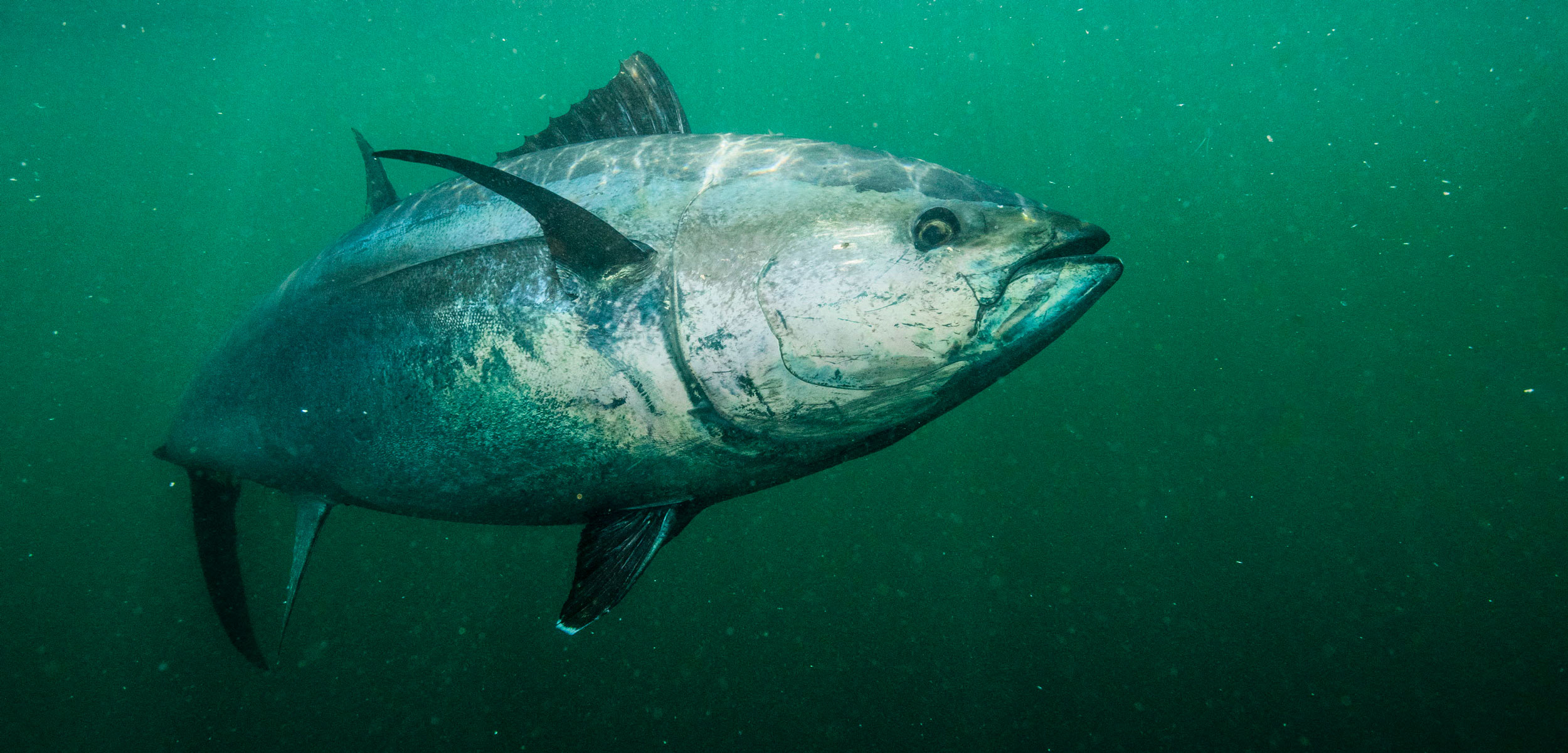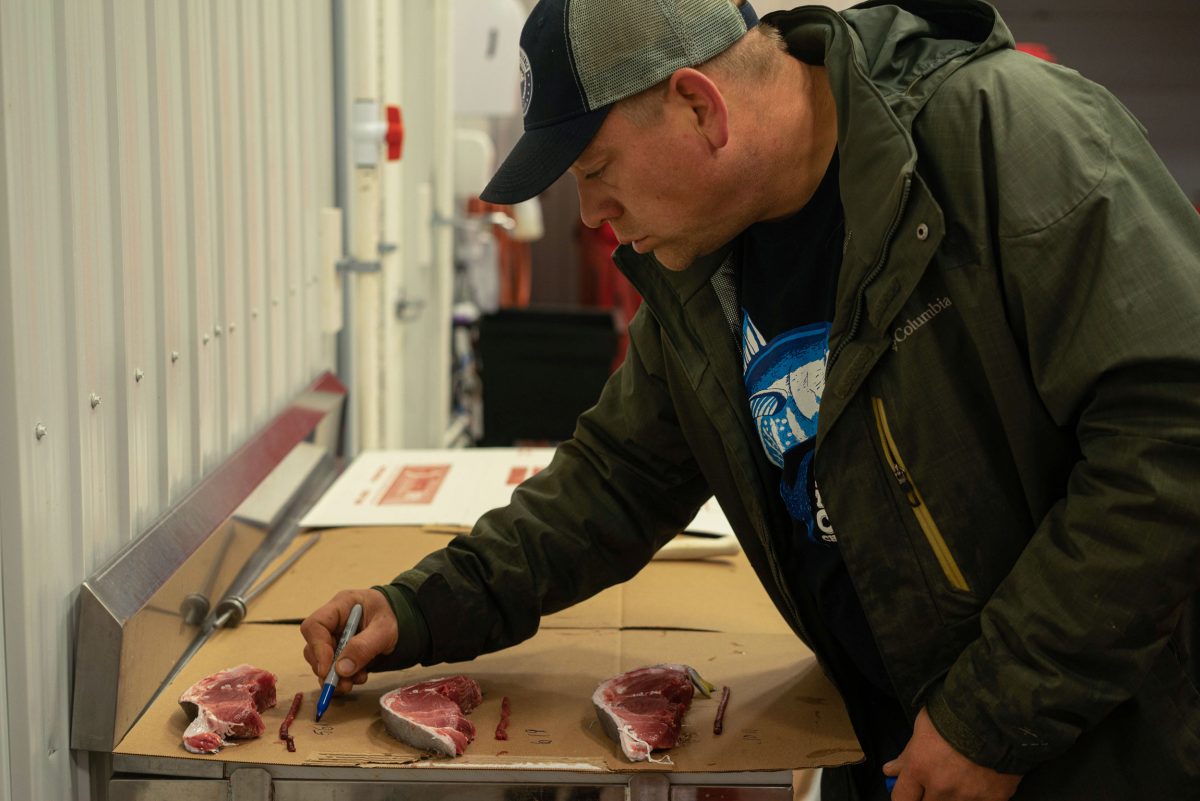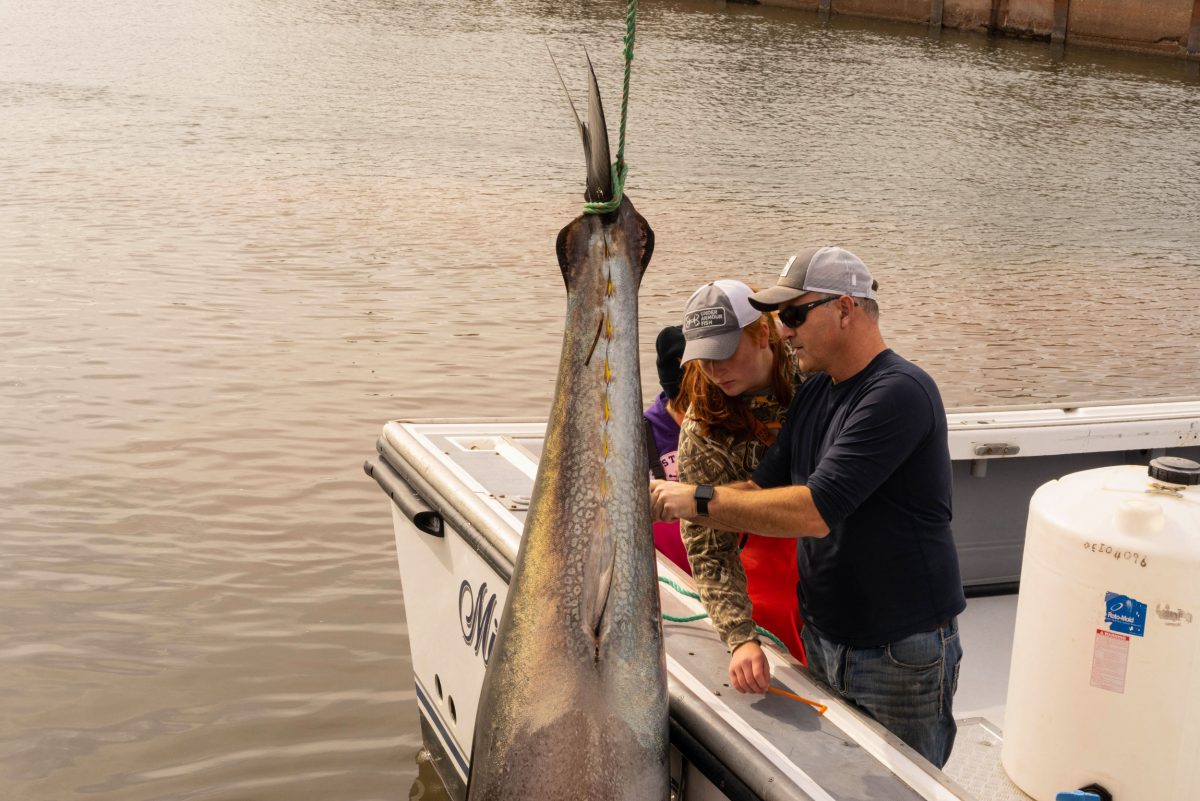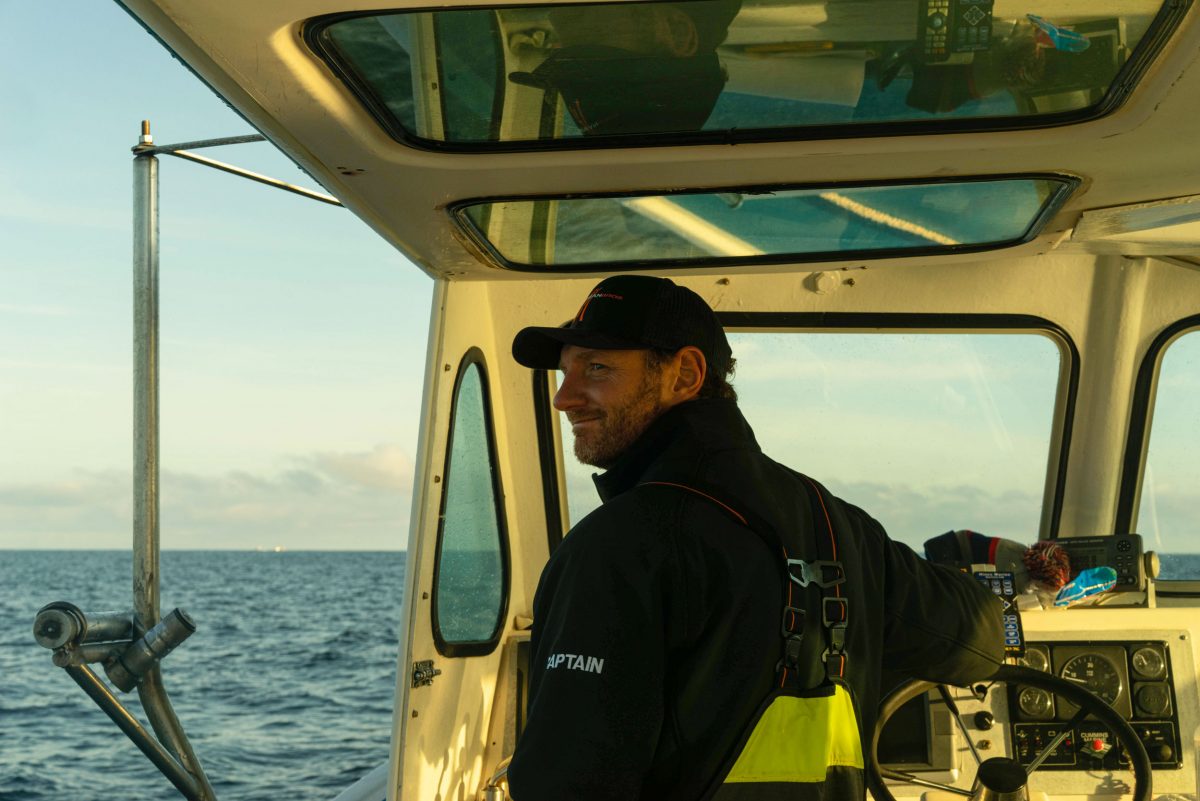A Tuna’s Worth
Bluefin tuna are a luxury that feeds the egos of many, the bellies of few. Inside a Canadian fishery that pursues them.
Article body copy
“Are your feet on red dirt yet?”
I gaze down at my feet. An hour after landing in Charlottetown, the soles of my boots are already stained the ocher of Prince Edward Island, Canada’s smallest province, off its southeast coast.
“I’ve got a fish hailed for 2 p.m. at North Lake,” Jason Tompkins continues, over my cellphone. “If you leave right now, you might just make it.” I start the car before he can finish and drive like hell, past the oil tanker in the Charlottetown harbor, past the American-owned blueberry processing plant, past the yellow autumn leaves still clinging to trees along the two-lane highway, toward the island’s eastern tip.
Sixty kilometers from North Lake, Tompkins blows past me in a blue flatbed truck, bandaged with duct tape and heavy with tanks of salt water and ice. He’s got one fish in the brine already, landed this morning in the village of Morell.
A crowd has gathered by the time we reach the wharf. It’s October 14, Canadian Thanksgiving, a day most people spend with their families. Across the harbor, the Pirates Boathouse Cafe has sold out of turkey dinners. Seagulls wheel and cry and the ocean slaps the docks. The sun is out and everyone is in a holiday mood. Everyone, that is, except Tompkins. He is all business all the time. “This is my workplace,” he grumbles as he tries to back a forklift into the crowd.
A boat pulls in and the crowd surges forward. The fish has arrived.
Tompkins steps into a pair of waders and pulls out a chainsaw. Red flesh from the last fish is still caught in its teeth.
North Lake, a community too small to support an ATM, calls itself the tuna capital of the world. In the 1960s and 1970s, anglers here regularly landed bluefin that broke world records. People came from all over the planet to hunt the storied giants, which swam faster and fought harder and grew bigger than any other sport fish. In 1979, a North Lake fisher named Ken Fraser caught the largest in history, at 679 kilograms. In a black-and-white photo commemorating the event, Fraser stands wide-eyed, blood-spattered, and completely dwarfed by the hanging behemoth—as if he were the prey, not the predator.
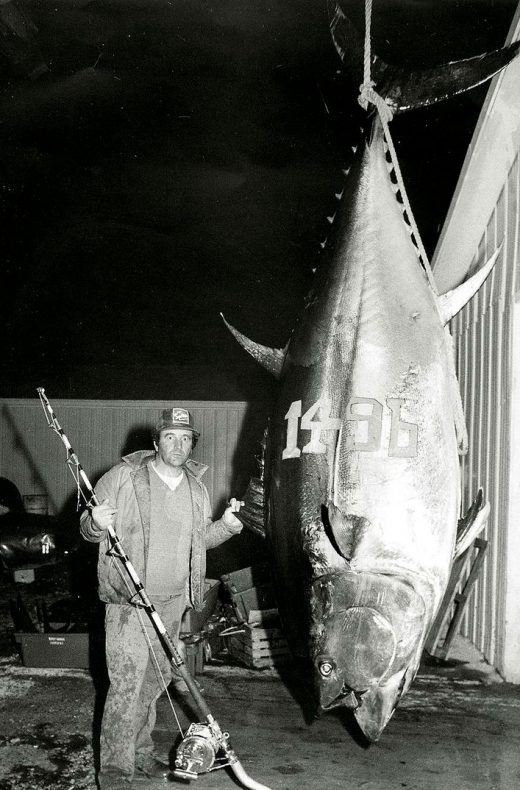
A Prince Edward Island fisher caught the largest recorded bluefin tuna in history in 1979. Photo courtesy of the International Game Fish Association
Victorious fishers would suspend their trophies from the bridge connecting the two sides of the harbor, but locals rarely bothered to eat them. The fatty meat went rancid quickly and tasted greasy when cooked. When the stench of rotting fish became unbearable, the tuna were dragged out to sea or buried in farmers’ fields.
On the other side of the world, in Japan, bluefin was well on its way to becoming the most expensive item on sushi menus. Toro, the meat cut from the belly, was especially sought after. Japanese diners were developing a taste for fattier flavors, perhaps in response to new foods introduced by American soldiers stationed on the island after the Second World War. New refrigeration technologies helped prevent the flesh from going rancid.
As demand and prices rose, so did fishing effort. In 1956, Japanese fishers pioneered the use of longlines for catching tuna, spooling out lines with thousands of hooks for up to 100 kilometers behind boats. Japanese, Korean, and Taiwanese factory trawlers with new refrigeration capacities were soon headed to faraway fishing grounds. Catches quickly began to decline. In the Atlantic, scientists predicted that Japan’s appetite for bluefin would threaten the entire stock. That’s because tuna are long-distance travelers: fishing them off one coast can affect the populations on another. Atlantic bluefin swim from the Gulf of Mexico to Newfoundland along North America’s Atlantic coast, and fish tagged in Canadian and US waters have been caught off France and Norway. Like most large predators, tuna are slow to reach maturity; killing many, quickly, can lead to steep population declines. And taking the largest individuals—the mega-spawners—can affect reproduction rates disproportionately.
By 2006, western Atlantic bluefin stocks had dropped by 80 percent, despite desultory efforts to regulate fisheries through the International Commission for the Conservation of Atlantic Tunas (ICCAT), which sets quotas for its member countries. One scientist estimated there was now a single bluefin for every 50 that swam in the Atlantic in 1940. An effort to ban international trade of Atlantic bluefin was proposed and abandoned. But an accompanying public relations campaign took off.
Environmentally minded restaurants in North America and the United Kingdom dropped tuna in general and bluefin in particular from their menus. Even in Japan, where people generally consider fishing and eating tuna to be their prerogative, organizations like Chefs for the Blue and Seafood Legacy worked to raise awareness about tuna’s vulnerability. Meanwhile, ICCAT and countries on both sides of the Atlantic doubled down on regulating catches.
A few years ago, North Lake bluefin began reappearing on ethical menus. Many chefs remained skittish, but several food writers I respect talked about a rod-and-reel operation that took just one fish at a time, with zero by-catch. Quotas were strictly enforced and stocks closely monitored.
Curious, I called Jason Tompkins, Prince Edward Island’s only full-time tuna broker.
“The most sustainable bluefin fishery in the world,” he said proudly. Its success is about value, not volume, he explained. If you take fewer fish, you can sell them for a higher price. “Catch less, take better care.”
Sylvie Lapointe, Canada’s assistant deputy minister for fisheries and harbor management, echoed Tompkins’s optimism. Western Atlantic bluefin biomass had increased 60 to 66 percent between 1990 and 2019, bucking global tuna trends.
I was intrigued. Was it possible Tompkins’s claim had some merit? And if the fishery was considered sustainable, did that fact justify flying these giants halfway around the world for sale to the highest bidder? Who, exactly, was benefiting from this arrangement?
“Come see for yourself,” Tompkins said. I told him I’d meet him in North Lake.
The crowd waits expectantly as the crew ties up at the dock. The captain, Jansen McKinnon, attaches a cable to a green rope at the boat’s stern. Miranda, his red-haired teenaged daughter, watches intently as he works. She fought this fish. She will feel the long struggle tomorrow, in the soreness of her muscles.
This fish.
The crane slowly pulls the forked tail out of the water. Even dead, the tuna is more beautiful than I imagined, muscular and glistening, with iridescent silver skin. Bright yellow fins run the length of its spine.
“Different tuna have different coloring,” says Tompkins, sizing up the fish with his large blue eyes. “Just like people.” A tuna changes color as it dies. “They call it flashing. A fish will go almost all white for five to 10 seconds. As soon as it’s dead, it comes back to a brilliant sheen.” Blood drips from the tuna’s mouth as the crane swings it ponderously over land. I imagine the fish darting easily through the water at 80 kilometers per hour, chasing roiling schools of herring and mackerel, hunting by sight.
Now the bluefin’s great eyes stare unseeing, and the onlookers stare back through their screens. They hold their phones in front of them as if in ritual offering. Most have never been so close to such a large wild creature. Maybe they are wondering, too, where it was born, how long it lived. There is no tag to tell us. It could have hatched in the Gulf of Mexico or the Mediterranean.
Red numbers flicker on the scale, and McKinnon and the crowd watch, rapt, the way gamblers watch slot machines. The weight of the fish gives the first clue to its worth on the global market.
228 kilograms.
McKinnon is optimistic. This fish won’t break any records, but sometimes smaller fish fetch higher prices at the Tokyo auction.
Japan still imports about 80 percent of the world’s bluefin catch, and Tokyo’s fish market is the largest in the world, the epicenter of the global seafood system. Since 1972, when the first North Lake bluefin left for Japan in a wooden box built by undertakers and filled with chipped ice, North Lake commercial fishers have dreamed of sending their catches there. By the 1990s, they could earn CAN $60 to $70 per kilogram. A broker might pay $20,000 for one bluefin—roughly equivalent to the average income in Prince Edward Island at that time. Some tuna went for $40,000. Then Japan’s bubble economy burst, and tuna ranching flooded the market with cheaper farmed fish. Twelve distributors in North Lake were whittled down to just two: Tompkins and his former employer, a San Diego–based company called Chubby Fish. In the last five years, the highest price Tompkins has paid for a wild-caught bluefin is $10,000.
A fish caught off Prince Edward Island on this particular day is of even more uncertain value. Typhoon Hagibis, soon to be deemed Japan’s costliest, has been wreaking havoc in the Pacific. Flights to and from Japan have been grounded for two days. Atlantic tuna have been sitting on the tarmac on North America’s east coast, losing freshness, losing value. In another six months, as the COVID-19 pandemic throws the global economy into a tailspin and kills hundreds of thousands of people, this will seem like an insignificant hiccup. But right now, the two-day grounding is a big deal. McKinnon has only one chance to catch a tuna each season, according to Canada’s complicated quota system. It’s for this reason that Tompkins opened a processing facility a few months earlier, so he can cut and freeze tuna when the market is saturated, and sell pieces to smaller buyers without depending on Tokyo’s auction.
Tompkins’s chainsaw begins to whir. The fish must be cut to fit the insulated cardboard box that will carry it. Fins first, then tail. The head rolls into a bucket. The gills are beautiful and intricate, like pages in a book fanned open. Tompkins pulls out organs with both hands. The action calls to mind a doctor delivering a baby, except Tompkins is midwifing death, not life. Later, he will hose himself down, but it’s impossible to get rid of the fresh tuna smell: bloody and meaty and almost earthy.

Tompkins trimming a bluefin to fit the cardboard box that will carry it through the global seafood trade. Photo by Sasha Chapman
How and when the tuna is killed greatly affects the quality of the meat. A tuna needs to cool down for 45 minutes to an hour after the long fight, just as an elite athlete would take an ice bath after a race. This dispels the lactic acid that builds up in the muscles. A well-treated fish might fetch three times the price. Life history also matters: what a fish ate and where it swam will affect its color and flavor and the grade that a tuna broker like Tompkins will give it. If he sees any “white cloud” in the tail flesh, it may devalue the fish considerably. White cloud indicates scar tissue—a tussle with a shark, maybe.
Tompkins cuts a slice off the tail and kneads it with his fingers. “Pretty good color, good marbling,” he says. “But I’d like a gummier texture.” Later, he’ll grade tail pieces and core samples and photograph them. Then his real work begins: calling up buyers of premium fish in Japan and New York. Toronto and Montreal may take lesser specimens.
When all is said and done, McKinnon will receive $3,880 for his tuna. For comparison, a single Japanese fish went for US $1.8-million at Tokyo’s fish market at the beginning of 2020. What money there is to make in the global tuna trade isn’t necessarily going to fishers. At North Lake, tuna fishers make most of their living doing other things: hauling lobster traps, taking tourists on charter tours, working office jobs. McKinnon works for an insurance company.
In 2009, Fisheries and Oceans Canada (DFO) established a catch-and-release bluefin fishery to increase local tuna profits. Wealthy sportfishing tourists spend lavishly to catch a trophy—thousands to charter a boat for the day, not to mention money on food and lodging. The charter fishery now brings more revenue to the province than the entire commercial tuna fishery. About 25 of the 350 or so fishermen in North Lake hold catch-and-release licenses.
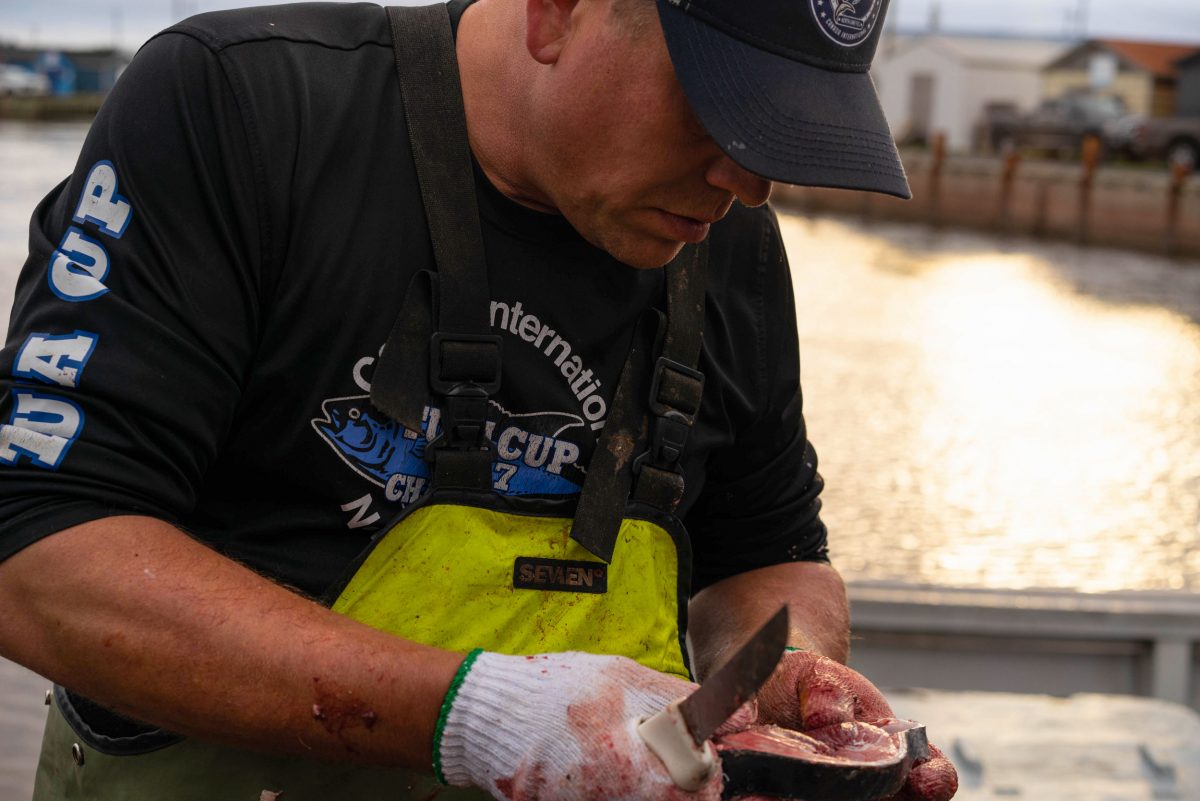
Tompkins examines a tuna sample cut from the tail. Marbling and flesh color will affect the price paid to the fisherman. Photo by Sasha Chapman
If charter captains hold a kill tag, they can also sell the catch, but that doesn’t always mean extra money. Boat captains send their tuna to Tokyo on consignment when a broker won’t take on the financial risk. Sometimes the fish ends up selling for less than the cost of shipping. “This year, well, I’m lucky if I don’t get a bill,” says Troy Bruce, who has been fishing at North Lake for four decades. “We shouldn’t be killing fish for that reason. They’re amazing creatures. They deserve respect.”
Other people on this small wharf in this small community prefer to talk about the good old days, the days when big fish were plentiful and tuna fishers could earn a good living. I listen and nod. But I can’t help feeling that the tuna capital—and the globalized food system that hungrily swallows its giants—is clinging to the past without much thought for the future. “Everyone is obsessed—possessed, if you want to call it like that,” says Bruce. “My mother always said they were the devil’s fish. They just make men do stupid things.”
By the time the last fish of the day arrives at the wharf, the crowd has thinned to a few tanned men drinking Coors Light. They offer me a can. We chat. They are here to hunt and fight and kill a giant. Before I can finish my beer, I have an invitation to tag along.
We meet on the wharf at dawn. The Good Enough is sparkling clean, pool blue and white. When the tuna season finishes, Captain Lorne Bonnell will outfit the boat to haul lobster, but today it is set up as a pleasure palace for sport fishers. Lobster rolls and cold beer fill the coolers, and the black-and-gold fishing rods gleam in the early morning light. The speakers blast classic rock. Bonnell steers us out of the flat-water harbor under a cloudless sky.
Bonnell’s client is also a peer. Jack Carlson runs a flashy 11-boat sportfishing operation out of Marathon, Florida. He also stars in his own reality television show. He has agreed to pay $3,000 for this day-long expedition. If he lands a bluefin, he won’t keep it; Bonnell, who technically holds the kill tag, will sell the fish to Tompkins.
Captain Jack, as Carlson calls himself, has brought three of his younger captains with him. Their excitement is palpable: none has ever caught a bluefin. They huddle together, hoods over baseball caps, rolling smokes. Meanwhile, Captain Jack chats on his cell in the wheelhouse, booking clients and talking to GoPro reps and designers for his new clothing line. “I want the hook on the left sleeve and the logo on the chest and on the back,” he says, flashing me a whitened smile.
To catch a tuna, first you must catch some bait—herring or mackerel, still very much alive and not too small. But those fisheries have their own troubles. Protections for mackerel and herring could be much stronger, and the lucrative lobster fishery depends on the same bait for its traps. There is talk of bait stocks collapsing—a blind spot in otherwise stringent government efforts to protect bluefin. Even with a fish finder that tracks animals underwater using sonar, it takes the younger captains the better part of the morning just to catch a dozen mackerel, their rods nodding down and up like Texas pump jacks.
Bonnell consults the fish-finder screen, filled with red crosses marking all the bluefin it has detected this season. He shrugs his shoulders—who knows where the tuna will be today—and cuts the engine. He and business partner Chris Mellish rig the bait. The idea is to use triangulating fishing lines and a kite to keep the bait mackerel swimming within sight, at the water’s surface. But the kite keeps lifting the wriggling mackerel into the air.
Bonnell worries that we are drifting too slowly to interest the tuna. We move to another site. To pass the time, the men jig for more bait and listen to crackling voices on the ship radio. Someone spots a massive basking shark, its large fin cutting majestically through the swell. We all pause to watch.
By 5 p.m., the captains have still caught nothing. Their window of opportunity is closing. Bonnell calls Tompkins: it doesn’t look promising.
Then, suddenly, a bluefin lurches out of the water at one of the baits.
The captains elect Mike Macko to fight. He stands facing the water, bracing himself at the edge of the boat, two hands on the rod. The hook sets in the fish.
“Golden hour hook up,” the men crow. They FaceTime Macko’s girlfriend.
Bonnell brings Macko a glove so the friction doesn’t blister his hand as he hauls on the line. The gears of the reel strain as he winds the handle. The rod dips, its line like an umbilical cord, connecting man to fish.
Sportfishing gear is designed to maximize feeling, this sense that the fisher and the fish are connected to one another. “You can feel every tail beat, every head shake,” Bruce tells me later. “You feel the pain, too. I’ve seen guys on the floor crying afterward, their legs all charley horsed up and feet soaking in buckets of water.” And all they can talk about is how it was the best day of their life.
Bonnell stands next to Macko—to steady the rod and keep it from swiveling too much, but also, it seems, to feel the fish, to feel like he has a part in this fight.
Minutes stretch into an hour.
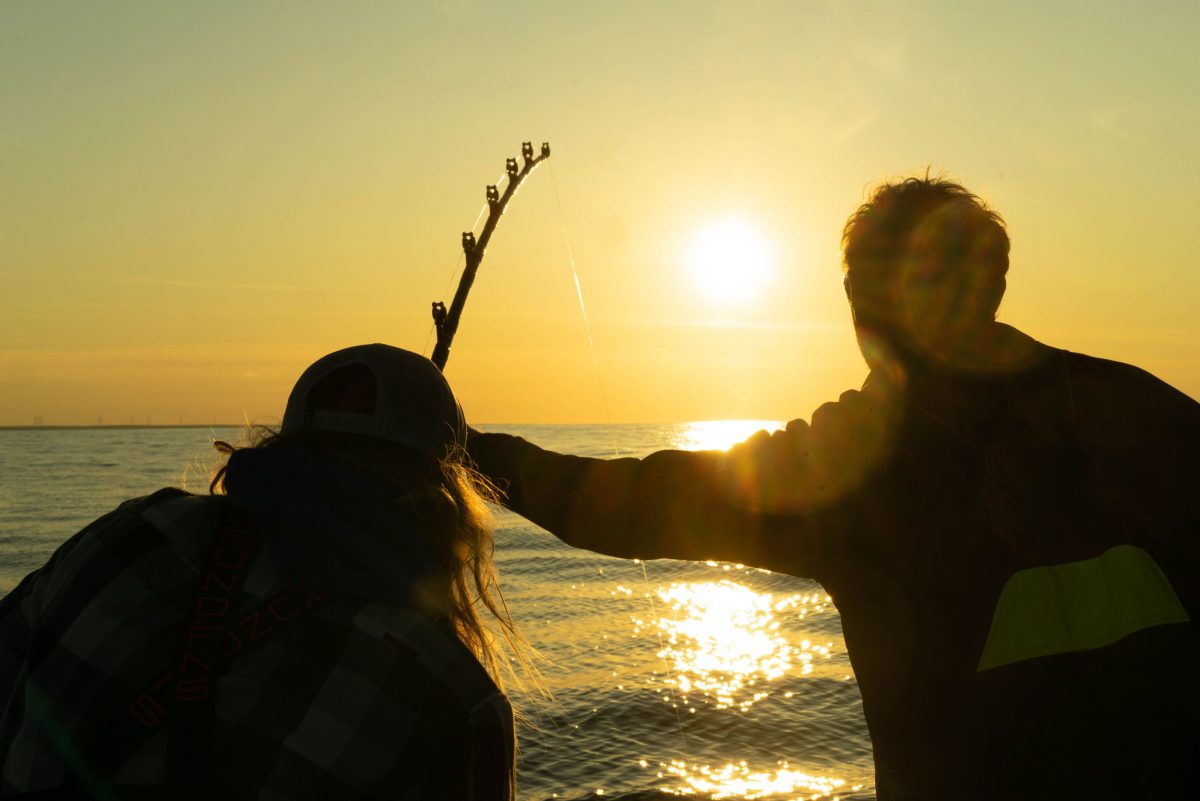
Bonnell steadies the rod while Mike Macko struggles to pull in a bluefin before the sun sets. Photo by Sasha Chapman
Captain Jack accuses Macko of fishing like a girl. “We should get you a pink reel,” he says.
“I like pink,” counters Macko. “It’s the color of pussy.”
Captain Jack looks at me and seems to realize they’ve crossed a line. “You’re one of the guys now,” he says. “You’re gonna go home to your husband and tell him what a saint he is.”
The sun begins to set and the air grows cold. Macko takes his jacket off: he’s sweating now. The other captains hold beer cans and smokes to his lips for relief.
Time passes and so does the celebratory mood. Can’t he just bring in the fish already?
A pale light glimmers in the dark water, then is gone.
When the tuna finally breaks the surface, it’s swimming on its side.
Bonnell tells me to watch out when the fish comes up. “Just be careful ’cause it’s madness.” Stand in the wrong spot, and I can easily get knocked overboard.
He and Mellish hang over the edge of the boat and slip a rope around the tuna’s thrashing tail. The gaff through its mouth resembles the bit a rider uses to control a horse. The clients hang over the edge, too. Everyone wants a picture. Bonnell and Mellish lift the fish up. It stares into dry air. I wonder what it sees in this suffocating world above water; it’s used to a more compressed view.
Then they let the line out again so the fish can swim slowly behind the boat to cool down.
The sun is slipping below the horizon, but the boat still proceeds at a funereal pace. The clients grow antsy. It’s dinner time, and the beer cooler is almost empty. Mellish leans over and cuts the tuna’s throat with a knife, then hoists it into the boat and hoses down the fish. Blood rushes down the drain holes in the stern. He needs to make three incisions, so Tompkins can more easily remove the innards at the wharf. But he can barely get to the fish. The clients are in his way, frenzied now, drunk on beer and drunk on the kill, kneeling by the creature as it enters its final death throes. Patting, taking selfies. They are in an alternate state, hyperaroused, hyperstimulated.
The tuna’s color flashes.
It goes pale, white.
Then silver blue again.
On my last day on the island, I head to the Inn at Bay Fortune, celebrity chef Michael Smith’s swish hotel outside of Souris. The tourists have all gone home for the season, and the property has been taken over by Forage, a two-day gathering of the province’s food community. To kick off the event, Chef Smith teaches a young man how to saber a bottle of sparkling wine from Nova Scotia.
Newfoundland’s most celebrated chef, Jeremy Charles, grills whelks over an open fire. A chef-instructor and his students demonstrate how to bake lobsters in a pit with hot rocks and smoldering seaweed, buried under a tarp. People shuck their own Prince Edward Island oysters and help themselves to fermented vegetables, grown and pickled at the inn. They are here to connect, with each other, with their food.
In the afternoon, Tompkins gives a talk about North Lake’s bluefin fishery while cooks prepare tuna belly in the open kitchen behind him. “We want you to know the whole story,” he says, imagining the life of this fish for his audience and the dangers it would have encountered. “It had quite an interesting shark bite on the tail.” Then he describes the tuna’s final fight with Dominic Eloquin, the Magdalen Islands fisherman who caught it. He holds up a laminated paper, the equivalent of a baseball card for each tuna he sells. There is a photo of the fish arriving at the wharf and its weight, the boat’s name, and the captain’s name. “This is more than just meat on a plate; it’s memories,” Tompkins says. “This is really a boat-to-plate full-circle experience.”
It’s easy to understand the allure. In his 2007 book, The Sushi Economy, Sasha Issenberg observes that “eating seafood is an ongoing flirtation in a long, unconsummated romance with the open water, the only terrain on Earth able to resist civilization.” When the fish on the plate comes with an origin story, it offers consumers a way to more intimately experience a place, an ecosystem, a natural world that sometimes feels far away. It may also help them learn to value that world.
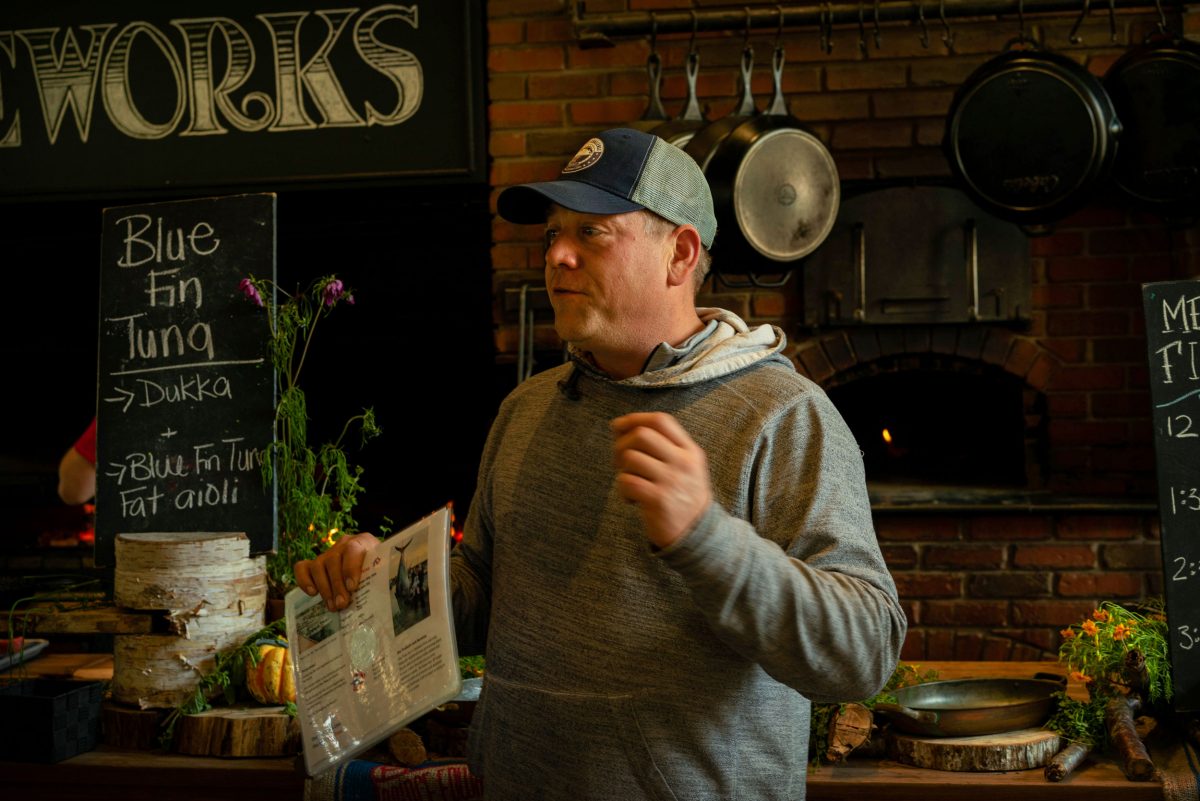
Tompkins giving a talk to an audience at Forage. The laminated paper he is holding is like a baseball card, giving diners stats and details about the tuna they are about to eat, and the fisherman who caught it. Photo by Sasha Chapman
Of course, fishing is more than romance for many people; artisanal and subsistence fishing may account for as much as a quarter of the global catch. It’s rooted in economic necessity and suffused with deep cultural meaning. But once a fish is sold into the global food system, it becomes a commodity. So do the stories used to sell it.
And what exactly is for sale? Even at North Lake, the tuna population is still just a fraction of what it was, despite increases in biomass. Western Atlantic bluefin stocks are only 17 to 20 percent of what they were in 1970, the year that traditional stock assessments began. No one knows how current numbers compare with 1864—the year considered the stock’s “virgin” state. “It’s challenging to manage a migratory fish at the local level,” Sylvie Lapointe will tell me later. Warming waters seem to be pushing bluefin farther north. Just because there are more bluefin around North Lake, she says, “that doesn’t mean the bluefin population overall is as healthy as one might think.”
And yet, Canada upped its total allowable catch in 2017, and may do so again. Other countries in the western Atlantic are also upping their quotas, following ICCAT’s lead. In January 2020, a sustainable seafood ratings program, Ocean Wise, announced it would begin recommending Atlantic bluefin caught by harpoon or handline to consumers, as long as a restaurant could provide documentation. Meanwhile, two longline bluefin operations in Japan and France have applied for an ecolabel from the Marine Stewardship Council, a certification program. Conservation scientists worry it may all be too much too fast.
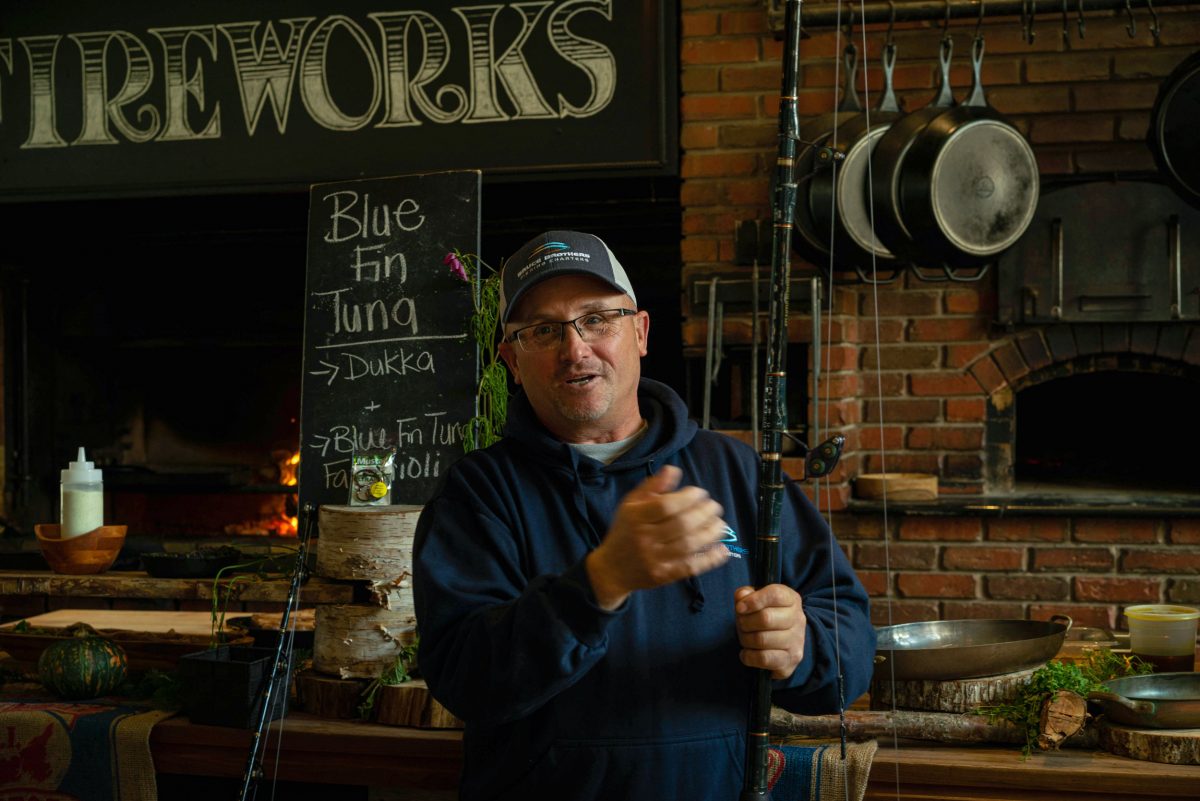
Tony Bruce, talking to the crowd at Forage about the charter tuna fishery and describing the rods they use to catch a fish. Photo by Sasha Chapman
And for what purpose? Bluefin is neither a staple nor a necessity. It’s a luxury. The person who dines on North Lake’s bluefin may want to connect to the people who caught it and the ocean it came from, but they are also buying a trophy, just as surely as Captain Jack did when he shelled out $3,000 for his charter experience. The word trophy comes from the Greek tropaion, a “monument of an enemy’s defeat.” It is, by definition, a spoil of war. North Lake’s relationship to bluefin tuna has always been adversarial. Fishermen are said to “fight” the fish, and they are celebrated as heroes when they win this unequal battle, armed with technologies that make the finding and killing ever more efficient, despite diminishing financial returns and the dwindling size of the catch. Commercial cod and lobster fishermen have also long seen themselves in competition with bluefin—hungry giants that feed on the same fish they needed to fatten up their catches.
This vision of wild creatures as targets of conquest or competition to be eliminated may have made some sense when human beings felt their everyday lives to be at the mercy of the natural world. But in the Anthropocene, the environment is often at our mercy, even when the ways we alter it ultimately harm our own species. Not only do humans en masse have the means and numbers to fish out entire species, we also have the power to change migration patterns by destroying habitat and warming ocean waters.
Tompkins’s fish tale makes sense when you are in a coastal hotel on a beautiful evening. But it blurs to abstraction when brokers fly a fish halfway around the world to be auctioned off at a market in Tokyo. Or even when they truck it to landlocked Toronto, where I live, and where the fish caught on the Good Enough will head in the morning. The distributor who bought it from Tompkins plans to parcel it out to sushi restaurants that may or may not mention its provenance on the menu. The much-vaunted connection is severed just a step or two down the global supply chain.
Tompkins finishes his sales pitch and the cooks set out little squares of tuna tataki. The crowd eyes the food hungrily. Troy Bruce, who has been sitting across a pine table from me, pushes back his chair and stands up. He wants a piece of Eloquin’s tuna belly before it disappears. In 40 years of fishing, he says, he has only once tasted toro—it’s the most valuable part of the fish, the one most prized in Japan. The only part of the tuna he’s ever taken home is the head, because it’s worthless to the global system. There’s not enough meat in it to pay for the extra cost of shipping.

